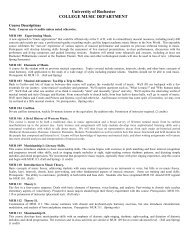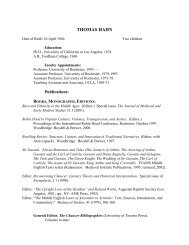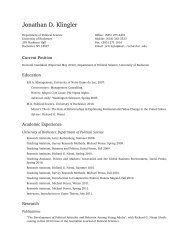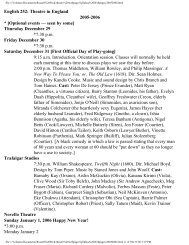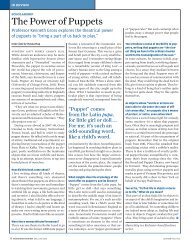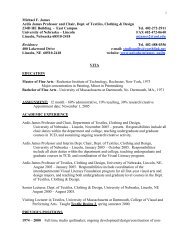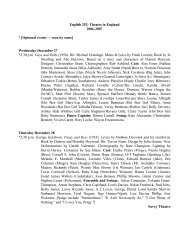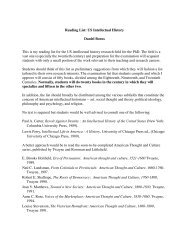William V. Ganis - Andy Warhol's Iconophilia - University of Rochester
William V. Ganis - Andy Warhol's Iconophilia - University of Rochester
William V. Ganis - Andy Warhol's Iconophilia - University of Rochester
Create successful ePaper yourself
Turn your PDF publications into a flip-book with our unique Google optimized e-Paper software.
<strong>William</strong> V. <strong>Ganis</strong> - <strong>Andy</strong> <strong>Warhol's</strong> <strong>Iconophilia</strong><br />
IN[ ]VISIBLE CULTURE<br />
AN ELECTRONIC JOURNAL FOR VISUAL STUDIES<br />
<strong>Andy</strong> <strong>Warhol's</strong> <strong>Iconophilia</strong><br />
by <strong>William</strong> V. <strong>Ganis</strong><br />
©2000<br />
In <strong>Andy</strong> <strong>Warhol's</strong> serial art, a media-reflexive gesture appears in the<br />
endless reproduction, dissemination, and simulacra made possible by<br />
photography and machines. <strong>Warhol's</strong> serial work is the "unpresentable<br />
presentation"[1] <strong>of</strong> infinite image repetition. It is this self-referentiality<br />
toward perpetual reproduction which gives these works their power and<br />
larger importance. In spite <strong>of</strong> his superficial naïvete, Warhol demonstrates<br />
self-awareness <strong>of</strong> his illimitable action, and presents this unpresentable<br />
infinity by implication. By completely covering the canvas with images,<br />
Warhol suggests that the picture plane continues ad infinitum and that there<br />
are always more images beyond the frame. One perceives more dollar bills,<br />
Coca-Cola bottles, and publicity photos <strong>of</strong> movie stars existing outside any<br />
one painting. Indeed, this implied repetition exterior to the painting takes<br />
place in the imagination. Gilles Deleuze points out that 'repetition is itself in<br />
essence imaginary... it makes that which it contacts appear as elements or<br />
cases <strong>of</strong> repetition."[2] In any serial Warhol work, visual repetends may or<br />
may not exist in the work itself, rather the absent repetition <strong>of</strong> a work's<br />
image is located in other Warhol art and the recurrence <strong>of</strong> similar images or<br />
objects situated in the rest <strong>of</strong> the world. Any notion <strong>of</strong> the 'original' is<br />
constantly deferred based on the repetition <strong>of</strong> such works and their endless<br />
http://www.rochester.edu/in_visible_culture/issue3/ganis.htm (1 <strong>of</strong> 14) [3/22/07 11:44:15 AM]
<strong>William</strong> V. <strong>Ganis</strong> - <strong>Andy</strong> <strong>Warhol's</strong> <strong>Iconophilia</strong><br />
return. Depending on the context <strong>of</strong> seeing a Warhol work, there seem to be<br />
multiple levels <strong>of</strong> repetition at play inside the piece, in other Warhol works,<br />
in the world, and as I shall examine below, in art history. One must ask what<br />
this repetition is, that defers and moves toward framing infinity. Friedrich<br />
Nietzsche's concept <strong>of</strong> the eternal return <strong>of</strong> the same, like <strong>Warhol's</strong><br />
photographic works, deals with problems <strong>of</strong> repetition, difference and<br />
history.<br />
The eternal return <strong>of</strong> the same is the thought that the world always recurs,<br />
that the actions we make have been repeated infinitely before us and will be<br />
repeated infinitely thereafter.[3] This concept is not as simple as saying that<br />
history repeats itself, because, as Deleuze points out, "The eternal return<br />
does not bring back 'the same', but returning constitutes the only same <strong>of</strong><br />
that which becomes."[4] This concept <strong>of</strong> 'the same' demonstrates that the<br />
repetition is understanding the same from the basis <strong>of</strong> each representation.<br />
However, Warhol in his image manifestations does not emphasize the world<br />
<strong>of</strong> difference, rather, his repeated works show that representation is a<br />
receding perspective. <strong>Warhol's</strong> art makes the standard, stereotyped, and<br />
repeated intensely perceptible. Rather than extract from difference like the<br />
Abstract-Expressionist artists did in their celebration <strong>of</strong> 'autonomous' works,<br />
Warhol conceded to repetition.<br />
<strong>Warhol's</strong> serial works operate on the principle that the infinite depictions<br />
invoke a foundation,[5] however, this 'original' source is always displaced in<br />
Warhol. Because the viewer <strong>of</strong> Warhol works is always aware <strong>of</strong> his<br />
multiples, the eternal return is unsubtle, yet there is still a fascination with<br />
finding 'originality' in these works. Anyone visiting the <strong>Andy</strong> Warhol<br />
Museum will be treated to the spectacle <strong>of</strong> the Warhol archives which<br />
contains the source materials for <strong>Warhol's</strong> art works. Though the archival<br />
goods have little monetary value compared to the art objects made by<br />
Warhol, they are "fetishized as the lost object" in lieu <strong>of</strong> <strong>Warhol's</strong><br />
"hyperreal"[6] paintings. In these materials, one can see the master's<br />
selection process, choosing images for his works. However, upon closer<br />
examination, we see that these archival ghosts used to make the art works<br />
themselves are simulacra <strong>of</strong> simulacra. <strong>Warhol's</strong> art is, as Deleuze defines<br />
simulacra, "not simple imitation but the act by which the very idea <strong>of</strong> a<br />
model or privileged position (an original) is overturned."[7] The archival<br />
http://www.rochester.edu/in_visible_culture/issue3/ganis.htm (2 <strong>of</strong> 14) [3/22/07 11:44:15 AM]
<strong>William</strong> V. <strong>Ganis</strong> - <strong>Andy</strong> <strong>Warhol's</strong> <strong>Iconophilia</strong><br />
sources <strong>of</strong> <strong>Warhol's</strong> images appropriated from earlier art serve this function<br />
<strong>of</strong> 'originality' in a strange way. These sources are the bases <strong>of</strong> <strong>Warhol's</strong><br />
works and <strong>of</strong>ten exist in a state <strong>of</strong> singularity (one silkscreen, one maquette,<br />
one cropped photo) that seems more original than the 'authentic' works<br />
examined below.[8]<br />
Perhaps the Warhol works which best fit this examination <strong>of</strong> repetition and<br />
simulacra are the paintings, prints and drawings derived from earlier well<br />
known works <strong>of</strong> art by other artists. Warhol appropriated such images<br />
throughout his 'fine' art career from 1963 until his death in 1987, a few days<br />
after the premier <strong>of</strong> his Last Supper works. The images selected by Warhol<br />
for re-presentation in silkscreened works are all art historically canonical. In<br />
Roland Barthes' terms, <strong>Warhol's</strong> appropriationist strategies are "archetypal<br />
acts" in their "imitating and repeating the gestures <strong>of</strong> another."[9] In his<br />
decisions to once again make images that themselves have had a history <strong>of</strong><br />
multiplicity, Warhol pays ritual obeisance to simulacra's worshipped<br />
ancestors.[10] For this investigation <strong>of</strong> originality and recurrence, I will focus<br />
upon the images taken from Leonardo da Vinci's Mona Lisa and Last<br />
Supper; Giorgio de Chirico's Italian Square, Orestes and Pylades, Hector and<br />
Andromache, Furniture in the Valley, The Poet and His Muse, and The<br />
Disquieting Muses; Edvard Munch's Eva Mudocci, Self-Portrait with<br />
Skeleton Arm, Madonna, and The Scream.[11]<br />
In choosing to render the images <strong>of</strong> Giorgio de Chirico, Warhol reenacted<br />
de Chirico's own strategy <strong>of</strong> repeating his own imagery. For de Chirico, this<br />
repetition was a means <strong>of</strong> remaining fiscally solvent in his later years. Dge<br />
Chirico still made works from his World War One era pittura metafisica<br />
style in the 1950s and 1960s. It was these later paintings that Warhol was to<br />
use as models for his After de Chirico works. Warhol said <strong>of</strong>, and projected<br />
through de Chirico,<br />
He repeated the same images over and over again. I like the idea a lot,<br />
so I thought it would be great to do it. I believe he viewed repetition as<br />
a way <strong>of</strong> expressing himself. This is probably what we have in<br />
common. The difference? What he repeated regularly, year after year,<br />
I repeat the same day in the same painting. All my images are the<br />
same, but very different at the same time... Isn't life a series <strong>of</strong> images<br />
http://www.rochester.edu/in_visible_culture/issue3/ganis.htm (3 <strong>of</strong> 14) [3/22/07 11:44:15 AM]
<strong>William</strong> V. <strong>Ganis</strong> - <strong>Andy</strong> <strong>Warhol's</strong> <strong>Iconophilia</strong><br />
that change as they repeat themselves?[12]<br />
Warhol recognized that de Chirico was making each repeated image outside<br />
<strong>of</strong> the historical framework in which the works had first gained their<br />
notoriety. The repeated de Chirico works <strong>of</strong> the '50s and '60s had little to do<br />
with the proto-Surrealist agenda through which these works would become<br />
known. These repeated works, however, did satisfy the art market conditions<br />
<strong>of</strong> 'originality' since they were executed by the hand <strong>of</strong> the master.<br />
Warhol also appropriated the works <strong>of</strong> Edvard Munch because, like de<br />
Chirico, Munch <strong>of</strong>ten repeated his own imagery, especially when he sold a<br />
painting which he felt conveyed a personal experience. The reason for this<br />
repetition Munch said, "...is that we see with different eyes at different<br />
times. We see things one way in the morning and another in the evening, and<br />
the way we view things also depends on the mood we are in. That is why<br />
one subject can be seen in so many ways and that is what makes art so<br />
interesting"[13] In addition to simply repeating his images in painting,<br />
Munch also rendered the same forms in wood block prints, lithographs, and<br />
etchings. These printed forms were all produced in multiple editions and<br />
<strong>of</strong>ten in several different media with color variations. Also, since Munch<br />
was skilled in all <strong>of</strong> these media, he sometimes developed images in prints<br />
that would later become paintings and vice-versa. This working process<br />
once again makes it impossible to identify any one original as multiples are<br />
made simultaneously.<br />
Leonardo da Vinci's Mona Lisa also suffers from an identity crisis as this<br />
work has had much history, myth, and speculative commentary constructed<br />
around it which has rendered it a simulacra. Surely the Mona Lisa is an<br />
iconographic simulacra in the context <strong>of</strong> popular art history. The identity <strong>of</strong><br />
the subject <strong>of</strong> the Mona Lisa, Lisa di Antonio Maria Gherardini, has been<br />
lost in the popular attention given to this work, which among other readings;<br />
denies her existence as some see the image as a transvestite portrait <strong>of</strong> da<br />
Vinci; or tell <strong>of</strong> an apocryphal love affair between her and the (now thought<br />
to be homosexual) artist. The Mona Lisa is one <strong>of</strong> the world's most<br />
reproduced images, as it has been used in advertising, consumer products,<br />
and art history, as a symbol for the infinitely more complex ideas <strong>of</strong> purity,<br />
love, the Louvre, 'high' culture, art, painting, and the Italian Renaissance. In<br />
http://www.rochester.edu/in_visible_culture/issue3/ganis.htm (4 <strong>of</strong> 14) [3/22/07 11:44:15 AM]
<strong>William</strong> V. <strong>Ganis</strong> - <strong>Andy</strong> <strong>Warhol's</strong> <strong>Iconophilia</strong><br />
1963 Warhol rendered the Mona Lisa in response to its exhibition in the<br />
United States at The Metropolitan Museum <strong>of</strong> Art.[14] In addition, the<br />
Gioconda has been labeled as an ideal in portraiture, the perfect infusion and<br />
revelation <strong>of</strong> a sitter's character by an artist. The holding up <strong>of</strong> this painting<br />
as such an ideal is a media (and intellectual) bastardization <strong>of</strong> the Platonic<br />
ideal, the defining notion from which all forms are derived.[15] (Perhaps all<br />
paintings are imperfect copies <strong>of</strong> the Mona Lisa?)<br />
Warhol also painted The Last Supper at a time when it was receiving much<br />
publicity upon the event <strong>of</strong> its restoration. The Warhol rendition, however<br />
was many times removed from The Last Supper on the wall at Santa Maria<br />
delle Grazie, in that Warhol used derivative source materials for these<br />
works. The photograph used for these works was taken from a cheap, massproduced<br />
reproduction <strong>of</strong> a nineteenth century copy.[16] As a Catholic,<br />
Warhol certainly knew the image first in this form, in the reproductions <strong>of</strong><br />
the painting that were standard issue in the blue collar kitchens and dining<br />
rooms <strong>of</strong> his fellow Eastern European Americans.<br />
With Munch, de Chirico, and da Vinci, Warhol uses the same strategy <strong>of</strong><br />
rendering the appropriated paintings so that these purloined works lose their<br />
identity and context and become images about images through seriality<br />
within and outside <strong>of</strong> the picture.[17] Warhol <strong>of</strong>ten makes paintings<br />
containing different numbers <strong>of</strong> repeated images. When Warhol produces a<br />
single image on the canvas, that image relies on the others like it in <strong>Warhol's</strong><br />
series to give it its meaning. The viewer <strong>of</strong> the the individual image work<br />
knows that others like it exist through the trace <strong>of</strong> the instrument <strong>of</strong><br />
reproduction, the silkscreened dot. These works can not be seen to exist for<br />
themselves but are dependent on the perception <strong>of</strong> the rest <strong>of</strong> the Warhol<br />
series (or at least familiarity with the Warholian strategy) to impart their<br />
import. In doubling the image on one canvas, Warhol makes the viewer even<br />
more immediately aware that the image is a replicate by showing a copy <strong>of</strong> a<br />
copy. <strong>Warhol's</strong> works with reproductions <strong>of</strong> three or more images on one<br />
canvas reveal that this copying is potentially infinite, especially when there<br />
are dozens <strong>of</strong> the same image in one space. In works like Thirty Are Better<br />
than One, there is the suggestion <strong>of</strong> more images beyond the picture plane<br />
and title as those contained within bleed out to the edges and are sometimes<br />
truncated. Moreover, these repetitions are <strong>of</strong>ten rendered by Warhol in a grid<br />
http://www.rochester.edu/in_visible_culture/issue3/ganis.htm (5 <strong>of</strong> 14) [3/22/07 11:44:15 AM]
<strong>William</strong> V. <strong>Ganis</strong> - <strong>Andy</strong> <strong>Warhol's</strong> <strong>Iconophilia</strong><br />
pattern which implies the infinite through the Euclidian geometry <strong>of</strong> the<br />
picture plane where the parallel lines never meet and infinite perpendiculars<br />
frame the same image.<br />
Further repetition, return, and simulacra exists beyond these Warhol<br />
works. Each Warhol artwork has been reproduced by The <strong>Andy</strong> Warhol<br />
Estate and Foundation in several four by five inch photographic<br />
transparencies. These transparencies have each been used dozens <strong>of</strong> times to<br />
reproduce the images by the thousands (sometimes millions), in articles,<br />
catalogs, and even on consumer schlock like postcards and jewelry boxes.<br />
Just like the dual eternal paths encountered by Nietzsche's Zarathustra on the<br />
mountainside,[18] the levels <strong>of</strong> simulacra develop endlessly on each side <strong>of</strong><br />
<strong>Warhol's</strong> art objects. We see that the paintings are but a sequence <strong>of</strong><br />
recurrences already preceded by the thousands and to be followed by the<br />
thousands. Reveling in the nature <strong>of</strong> seriality, Warhol shows a simultaneous<br />
understanding <strong>of</strong> the past and the future <strong>of</strong> the images in these works.[19]<br />
The privileged physical art object represents in Nietzschean terms, 'the<br />
moment,'[20] the gateway from which eternal recurrence precedes and<br />
recedes, and where precessions and future yield come together. The<br />
painting, rather than the singular silkscreen is analogous to 'the moment'<br />
since the painted canvas is the object <strong>of</strong> an artwork come into being, a<br />
tangible presence, a commodifiable object that is the final output <strong>of</strong> artistic<br />
communication. With the image serigraphed onto canvas, and stretched,<br />
signed, or stamped, all the codes are resolved, indicating to the art market<br />
that a work <strong>of</strong> art has been made. The silkscreen itself is but a precession <strong>of</strong><br />
the recognizable artwork. The silkscreen, in its ephemeral appearance and<br />
barely perceptible value inversion serves not as the artwork, but as a deictic<br />
device <strong>of</strong> possibility. If the silkscreen has any commodity value, it is as an<br />
agent <strong>of</strong> reproduction, a means <strong>of</strong> making more artistic 'moments' or<br />
paintings.<br />
An examination <strong>of</strong> any series <strong>of</strong> Warhol works reveals the strategies <strong>of</strong> the<br />
artist to create much difference in repeating the same simply through the<br />
manipulation <strong>of</strong> the placement <strong>of</strong> the image. 'Placement' in this sense means<br />
how Warhol and his assistants stretched each canvas around one or several<br />
screened images. In producing these images, Warhol usually painted a large<br />
sheet <strong>of</strong> canvas with selected ground colors, and would then have an image<br />
http://www.rochester.edu/in_visible_culture/issue3/ganis.htm (6 <strong>of</strong> 14) [3/22/07 11:44:15 AM]
<strong>William</strong> V. <strong>Ganis</strong> - <strong>Andy</strong> <strong>Warhol's</strong> <strong>Iconophilia</strong><br />
silkscreened several times on that canvas. Once the paint had dried, the<br />
canvas was cut and stretched onto uniform purchased stretcher bars. As the<br />
screened images were either slightly larger or slightly smaller than the<br />
stretched canvas' surface, some variation occurs in the visual presentation <strong>of</strong><br />
each image, giving the appearance <strong>of</strong> registration or mis-registration as<br />
would be produced by a mechanical printing process. It is in this process that<br />
Warhol causes any real differentiation in his images. Colors and registration<br />
vary slightly allowing the viewer to actually perceive differences among the<br />
works. Also, Warhol made the decision as to how many repeated images<br />
would appear on a single canvas. A lack <strong>of</strong> centering in these paintings<br />
illustrates Zarathustra's observation <strong>of</strong> perpetuity, "The middle is<br />
everywhere."[21] By comparing these differences one sees that what is the<br />
same in each <strong>of</strong> these paintings simply returns unto the image itself.<br />
Simultaneously, the similar returns to another object for comparison.[22]<br />
Thus the eternal return in <strong>Warhol's</strong> arena affirms difference within the same.<br />
From the perspective <strong>of</strong> dissimilarity, no matter how slight, the viewer can<br />
not deny the existence <strong>of</strong> similarity.<br />
In <strong>Warhol's</strong> screened works, the optical properties <strong>of</strong> the image are clear to<br />
the viewer. The variation in tone achieved by <strong>Warhol's</strong> use <strong>of</strong> one or more<br />
screened colors <strong>of</strong> paint is decorative rather than illusionistic. Any highlights<br />
or shadows created in these works is incidental and the seemingly arbitrary<br />
manipulation <strong>of</strong> colors that occurs both in one work or a series <strong>of</strong> works is<br />
so extreme that it defies illusionistic depth in his pictures. What the viewer<br />
reads as the highlights <strong>of</strong> these Warhol works is nothing more than optical<br />
colors advancing over dark tones or the space between the dots on a ground<br />
<strong>of</strong> canvas or paper. Notice here that I say ground and not background, for the<br />
figure-ground relationship is not easily established. Despite the fact that the<br />
screened ink is on top <strong>of</strong> the painted surface, the ground in these works is<br />
not the background as there is no depth. The ground is part <strong>of</strong> the medium<br />
which makes the gestalt perception <strong>of</strong> the images possible at all. Indeed,<br />
depth is eliminated in the appropriated image's dot pattern and this surface<br />
existence at its fundamental negates the image's 'being'. The critic Robert<br />
Melville pointed out this contradiction <strong>of</strong> the subject stating, "The successful<br />
work is in short a paraphrase <strong>of</strong> the blank surface it adheres to. American<br />
Pop painting is an ingeneous way <strong>of</strong> painting Nothingness."[23] In negating<br />
the image it is difficult to discuss difference if images at all, since all <strong>of</strong><br />
http://www.rochester.edu/in_visible_culture/issue3/ganis.htm (7 <strong>of</strong> 14) [3/22/07 11:44:15 AM]
<strong>William</strong> V. <strong>Ganis</strong> - <strong>Andy</strong> <strong>Warhol's</strong> <strong>Iconophilia</strong><br />
<strong>Warhol's</strong> images are essentially, perceived in the same manner <strong>of</strong> diminished<br />
extensity. When we reduce the Warhol image to its base elements <strong>of</strong> dot and<br />
color, we see that the "parts precede and make possible the representation <strong>of</strong><br />
the whole." Thus, as Kant would note, there are no 'internal differences' in<br />
these Warhol images, rather, difference would only be perceived as an<br />
'external relation' that must be perceived by the 'empirical intuition' <strong>of</strong> the<br />
viewer.[24] From this perspective, one could see that these optical properties<br />
subsume all <strong>of</strong> the Warhol serial works, since all <strong>of</strong> the paintings, prints, and<br />
works on paper operate with the same optical strategies and their images are<br />
all subject to the same optical metaphysics.<br />
Warhol made the dot, ground, and depth problem most obvious in his<br />
Shadows works <strong>of</strong> 1978. In these works, there are no recognizable images<br />
for our gestalt sensibilities to tangle with. The images are seemingly fully<br />
abstract; yet, like the appropriated images, they are derived from<br />
photographs, blown-up, contrast-reduced in the making <strong>of</strong> the silkscreen,<br />
and painted. The figure-ground relationship is further problematized in these<br />
works by the fact that Warhol painted the canvas surface in impasto<br />
expressionistic swaths <strong>of</strong> Liquitex, thus the 'grounds' in these works usually<br />
suggest more depth than the screened 'figures'.<br />
The most consequential aspect <strong>of</strong> <strong>Warhol's</strong> art objects that is invariably<br />
overlooked by scholars is <strong>Warhol's</strong> ability to exploit the art market by<br />
creating works containing the same images in both paintings and prints. For<br />
these appropriated paintings made between 1963 (Mona Lisa) and 1986 (The<br />
Last Supper), Warhol produced hundreds <strong>of</strong> works. The art market however,<br />
regards each one <strong>of</strong> these paintings as a Warhol 'original,' thus the price <strong>of</strong><br />
each work is commensurable with unique paintings by other artists. The<br />
confusion sets in when one considers that Warhol allowed numbered limited<br />
edition prints <strong>of</strong> these same works to be published as well. In 1982 (Goethe)<br />
and in 1984 (Details from Renaissance Paintings), Warhol also made limited<br />
edition screen prints <strong>of</strong> the same appropriated images he used in paintings.<br />
In printmaking, the concept <strong>of</strong> an edition is that <strong>of</strong> limiting the repetition,<br />
and the numbering <strong>of</strong> each print is a means <strong>of</strong> quality control for the prints.<br />
Traditionally, editions <strong>of</strong> wood block prints and etchings were numbered<br />
due to the wear to the s<strong>of</strong>t material plates that occurred with each printing<br />
cycle. With these methods <strong>of</strong> printing, the finest details were <strong>of</strong>ten lost in the<br />
http://www.rochester.edu/in_visible_culture/issue3/ganis.htm (8 <strong>of</strong> 14) [3/22/07 11:44:15 AM]
<strong>William</strong> V. <strong>Ganis</strong> - <strong>Andy</strong> <strong>Warhol's</strong> <strong>Iconophilia</strong><br />
later repetitions, thus collectors sought the prints struck first, corresponding<br />
to the lowest numbers. This privileging <strong>of</strong> the primary prints struck by a<br />
certain plate is the means by which print connoisseurs retain the idea <strong>of</strong> the<br />
"aura <strong>of</strong> the original" as defined by Walter Benjamin.[25] Since the first<br />
prints have a higher degree <strong>of</strong> integrity reflecting the artist's conception, they<br />
are closest to the idea <strong>of</strong> the original. <strong>Warhol's</strong> method <strong>of</strong> making prints,<br />
however, is antithetical to this valuation process since his printing plate was<br />
a silkscreen which if kept clean, would not deteriorate during the creation <strong>of</strong><br />
the prints. (Silkscreened edition prints are usually called serigraphs or<br />
screenprints.) Despite the uniformity in quality, <strong>Warhol's</strong> prints are still<br />
vestigially numbered and the lowest numbers are still the most valuable.<br />
In addition to the prints, Warhol also manipulates the category <strong>of</strong> 'drawing'<br />
in his appropriated works. Because <strong>of</strong> the curatorial skills needed to<br />
maintain works <strong>of</strong> art on different media, an artificial distinction has been<br />
established between works on paper and works on more stable supports,<br />
such as panel or canvas. Works on paper (with the exception <strong>of</strong> prints) have<br />
become associated with the curatorial and art market niche for drawings,<br />
whether they are actually paint, graphite, ink, etc. on paper. Furthermore, the<br />
large auction houses, Christie's, Sotheby's et al, divide 'types' <strong>of</strong> works<br />
including paintings, drawings, and prints, to be sold at different sessions.<br />
Warhol has executed thousands <strong>of</strong> works screened onto paper that have<br />
come into this gallery and auction market niche. For instance, his Madonna<br />
(after Munch), 1983, was executed on Arches Aquarelle paper, but it has the<br />
exact same screen (image) size <strong>of</strong> the works made on canvas. To further<br />
confuse the issue <strong>of</strong> works on paper as drawings, Warhol made thousands <strong>of</strong><br />
bona fide hand executed drawings with graphite or ink on paper. Each <strong>of</strong><br />
these drawings is unique in image although the subject matter is <strong>of</strong>ten<br />
repeated by Warhol in several drawings. These individually rendered works<br />
operate as they should in the art marketplace, as individual works. However,<br />
these legitimate drawings also prop up the legitimacy <strong>of</strong> the other Warhol<br />
works on paper by giving the aura <strong>of</strong> individuality by association.<br />
The idea <strong>of</strong> the published print or work on paper is further corrupted by<br />
Warhol, as he made thousands <strong>of</strong> screen prints that were never published.<br />
Some <strong>of</strong> these works have been designated 'trial pro<strong>of</strong>s' that are unique<br />
ins<strong>of</strong>ar as they include different color combinations from the published<br />
http://www.rochester.edu/in_visible_culture/issue3/ganis.htm (9 <strong>of</strong> 14) [3/22/07 11:44:16 AM]
<strong>William</strong> V. <strong>Ganis</strong> - <strong>Andy</strong> <strong>Warhol's</strong> <strong>Iconophilia</strong><br />
editions. Some <strong>of</strong> these prints are even more unique in that they were made<br />
in anticipation <strong>of</strong> editions that were never executed or published. The<br />
poignant aspect <strong>of</strong> these pro<strong>of</strong>s is that they are valued less than screen prints<br />
that have been designated individual works on paper, though the pro<strong>of</strong>s at<br />
times may be less numerous. One means <strong>of</strong> valuing these prints in Warhol<br />
connoisseurship is the presence or absence <strong>of</strong> a printer's chop mark, an<br />
embossing which reveals the printing studio where such a work is made. In<br />
the case <strong>of</strong> these works, the chop is that <strong>of</strong> Rupert Jason Smith, <strong>Warhol's</strong><br />
print publisher from 1976 until <strong>Warhol's</strong> death in 1987. This mark seems<br />
inconsequential, however, when one considers that in <strong>Warhol's</strong> studio, a<br />
number <strong>of</strong> painting assistants (not Warhol) also rendered the image on to<br />
paper or canvas through the silkscreening process that was identical to that<br />
used by Smith.<br />
In reviewing the problem <strong>of</strong> the relationship between <strong>Warhol's</strong> screened<br />
prints, paintings, and drawings, one concludes that all <strong>of</strong> these images are<br />
rendered by the same process, but the art market differentiates the value<br />
based on whether such an image is reproduced on canvas or paper; published<br />
in a portfolio or unpublished; or designated a 'unique' work on paper or a<br />
unique print pro<strong>of</strong>. These qualities determine whether a particular Warhol<br />
work is worth a few thousand dollars or tens <strong>of</strong> thousands <strong>of</strong> dollars.<br />
Remember that this differentiation in price is usually determined by the<br />
relative rarity <strong>of</strong> the original compared with the multiple. It is an amazing<br />
fact that this differential valuation still occurs in the auction and gallery<br />
market today, although it has clearly been determined that any one Warhol is<br />
hardly an original. Moreover, the paintings and 'works on paper' are not<br />
numbered or valued according to number, though in reality they have been<br />
executed just like a print. Because these prints are derived from the<br />
paintings, and the paintings themselves are not numbered, it is impossible to<br />
say that there is any 'original' Warhol work.[26]<br />
Warhol once said "I think every painting should be the same size and the<br />
same color so they're all interchangeable and nobody thinks they have a<br />
better painting or a worse painting... Besides even when the subject is<br />
different, people want the same painting."[27] "And they'd all be<br />
masterpieces because they'd all be the same painting."[28] In light <strong>of</strong> this<br />
statement one remembers that the screened images in Warhol works were all<br />
http://www.rochester.edu/in_visible_culture/issue3/ganis.htm (10 <strong>of</strong> 14) [3/22/07 11:44:16 AM]
<strong>William</strong> V. <strong>Ganis</strong> - <strong>Andy</strong> <strong>Warhol's</strong> <strong>Iconophilia</strong><br />
produced in the same way, and this collective <strong>of</strong> images produced by similar<br />
means encompasses a majority <strong>of</strong> the works in <strong>Warhol's</strong> oeuvre. Of course,<br />
any one <strong>of</strong> these images stands in and refers to images <strong>of</strong> its likeness, and<br />
the art historical 'original' from which it was derived. However, due to<br />
similarity in process, any one <strong>of</strong> these images may refer to all <strong>of</strong> <strong>Warhol's</strong><br />
screened works. For any Warhol serial, the overarching subjects are<br />
repetition, levels <strong>of</strong> simulacra, and an image's potential for infinite<br />
representation. Of course, the choice <strong>of</strong> the image's subject results in that<br />
subject's being carried by the vehicle <strong>of</strong> endless return, and <strong>of</strong>ten results in<br />
that image becoming decorative or having that image's sense <strong>of</strong> 'originality'<br />
debased. What the viewer really sees is the surface <strong>of</strong> painted grounds, and<br />
silkscreened dots that have been repeated ad infinitum. The viewer must not<br />
forget, however, that the slight differences in <strong>Warhol's</strong> works are also made<br />
perceptible by the process <strong>of</strong> the eternal return. It is precisely these subtle<br />
differences that make the repeated images on the same canvas visually<br />
interesting and which can make the observed recurrence return from the<br />
infinite to the individual canvas. It is this gesture <strong>of</strong> wanton repetition that<br />
showcases <strong>Warhol's</strong> awareness <strong>of</strong> this same action <strong>of</strong> repeating, as repeated<br />
in the images examined above, by others and society at large.<br />
Notes<br />
1. Jacques Derrida, The Truth in Painting, trans. Ge<strong>of</strong>f Bennington and Ian<br />
McLeod (<strong>University</strong> <strong>of</strong> Chicago Press, 1987), 125.<br />
2. Gilles Deleuze, Difference and Repetition, trans. Paul Patton (Columbia<br />
<strong>University</strong> Press, New York, 1994), 76.<br />
3. Joan Stambaugh, The Problem <strong>of</strong> Time in Nietzsche, trans. John F.<br />
Humphrey (Bucknell <strong>University</strong> Press, Lewisburg, PA, 1987), 163.<br />
4. Deleuze, 41.<br />
5. Deleuze, 49.<br />
http://www.rochester.edu/in_visible_culture/issue3/ganis.htm (11 <strong>of</strong> 14) [3/22/07 11:44:16 AM]
<strong>William</strong> V. <strong>Ganis</strong> - <strong>Andy</strong> <strong>Warhol's</strong> <strong>Iconophilia</strong><br />
6. For more on the fetishized lost object see Jean Baudrillard, "The Hyperrealism<br />
<strong>of</strong> Simulation", in Jean Baudrillard: Selected Writings, Mark Poster,<br />
ed., trans. Charles Levin (Stanford <strong>University</strong> Press, 1988) 143-47.<br />
7. Deleuze, 69.<br />
8. For more illustrations <strong>of</strong> <strong>Warhol's</strong> appropriationist art works see, Jorg<br />
Schellman, ed., <strong>Andy</strong> Warhol: Art from Art, (Edition Schellman, Munich,<br />
1994)<br />
9. Roland Barthes, "That Old Thing, Art" in The Responsibility <strong>of</strong> Forms<br />
(New York: Hill and Wang, 1985), 202.<br />
10. Carol Anne Mahsun writes a section regarding "The Consciousness <strong>of</strong><br />
the Primitive" in the sixth chapter <strong>of</strong> Pop Art and the Critics (Ann Arbor:<br />
UMI Press, 1987), 111-114.<br />
11. Warhol also appropriated for other silkscreen works from St. George and<br />
the Dragon, by Paolo Uccello; Sandro Botticelli's Birth <strong>of</strong> Venus; Piero della<br />
Francesca's Madonna and Child with Angels and Six Saints and St.<br />
Apollonia; Lucas Cranach the Elder's Portrait <strong>of</strong> a Young Woman; Johann<br />
Tischbein's Goethe in the Compagna; Henri Matisse's Woman in Blue; and<br />
Pablo Picasso's Zervos. These works will be referred to in the discussion<br />
below regarding <strong>Warhol's</strong> estrangement <strong>of</strong> art market categorizations.<br />
12. Victor Bockris, The Life and Death <strong>of</strong> <strong>Andy</strong> Warhol, (Bantam Books,<br />
New York, 1989), 326.<br />
13. Ragna Stang, Edvard Munch: The Man and His Art, trans. Ge<strong>of</strong>frey<br />
Culverwell (New York, 1979), 16.<br />
14. Laslo Glozer, "A Guest Performance on the Painters' Olympus" in <strong>Andy</strong><br />
Warhol: Art from Art, ed. Jorg Schellman (Edition Schellman, Munich,<br />
1994), 7.<br />
15. Deleuze, 60.<br />
http://www.rochester.edu/in_visible_culture/issue3/ganis.htm (12 <strong>of</strong> 14) [3/22/07 11:44:16 AM]
<strong>William</strong> V. <strong>Ganis</strong> - <strong>Andy</strong> <strong>Warhol's</strong> <strong>Iconophilia</strong><br />
16. Michael L½thy, "The Apparent Return <strong>of</strong> Representation: Ambivalence<br />
Structures in <strong>Warhol's</strong> Early Work" in <strong>Andy</strong> Warhol: 1960-1986 (Fundacio<br />
Joan Miro, Barcelona, 1996), 211.<br />
17. Rupert Jason Smith, in Schellmann, <strong>Andy</strong> Warhol: Art from Art, 77.<br />
18. Friedrich Nietzsche, Also Sprach Zarathustra, trans. Thomas Common,<br />
(New York: Heritage Press, 1967) 148. "Two roads come together here:<br />
these hath no one yet gone to the end <strong>of</strong>. This long lane backwards: it<br />
continueth for an eternity. And that long lane forward-that is another<br />
eternity."<br />
19. Donald E. Carr, The Eternal Return, (Doubleday & Co., Inc., Garden<br />
City, NY, 1968), 109.<br />
20. Nietzsche, Also Sprach Zarathustra, 148. "They are antithetical to one<br />
another, these roads; they directly abut on one another:-and it is here, at this<br />
gateway, that they come together. The name <strong>of</strong> the gateway is inscribed<br />
above: 'This moment.'"<br />
21. Nietzsche, Also Sprach Zarathustra, 207.<br />
22. Deleuze, 300.<br />
23. Robert Melville, "Sewing is Connection," New Statesman, April 7, 1967,<br />
481.<br />
24. Deleuze, 232.<br />
25. Walter Benjamin, "The Work <strong>of</strong> Art in the Age <strong>of</strong> Mechanical<br />
Reproduction", Video Culture, 30.<br />
26. Might a drop in the value <strong>of</strong> these paintings occur when the catalogue<br />
raisonné <strong>of</strong> <strong>Warhol's</strong> work is published? Surely collectors will be<br />
scandalized when they reveal that there are hundreds <strong>of</strong> 'originals' in<br />
existence.<br />
http://www.rochester.edu/in_visible_culture/issue3/ganis.htm (13 <strong>of</strong> 14) [3/22/07 11:44:16 AM]
<strong>William</strong> V. <strong>Ganis</strong> - <strong>Andy</strong> <strong>Warhol's</strong> <strong>Iconophilia</strong><br />
27. <strong>Andy</strong> Warhol, The Philosophy <strong>of</strong> <strong>Andy</strong> Warhol (From A to B & Back<br />
Again), (Harcourt Brace Jovanovich, New York, 1975), 149.<br />
28. Ibid., 148.<br />
Return to Table <strong>of</strong> Contents<br />
http://www.rochester.edu/in_visible_culture/issue3/ganis.htm (14 <strong>of</strong> 14) [3/22/07 11:44:16 AM]



